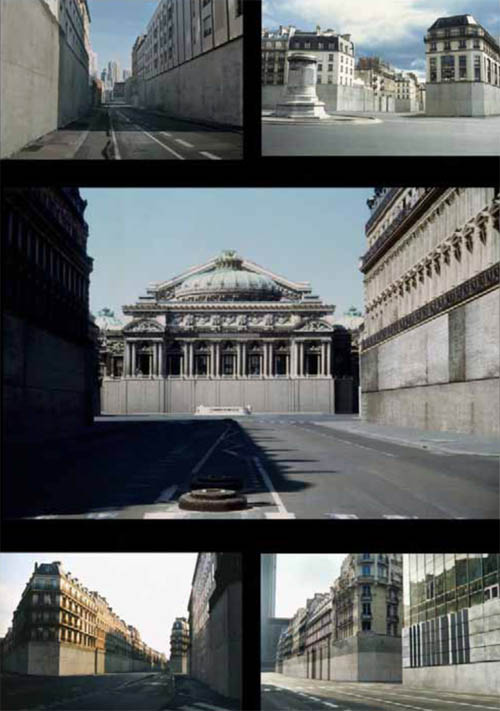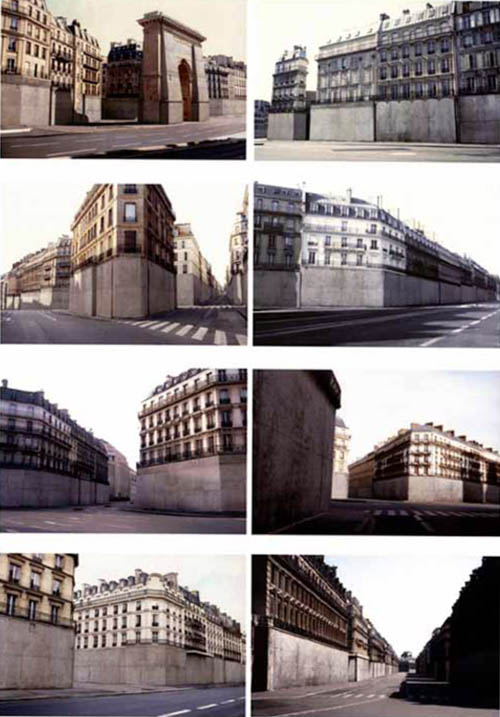Empty Paris
Pruned posted an image the other day by artist Nicolas Moulin (more of whose work can be seen over at Vulgare). Looking into Moulin's work further, however, I came across another series he produced a little more than a decade ago called Vider Paris. Here, we see Paris transformed into an abandoned maze of lifeless streets. Every building is sealed shut behind a seamless, Berlin Wall-like concrete monolith.
 [Images: From Vider Paris (1998-2001) by Nicolas Moulin, courtesy of Galerie Chez Valentin].
[Images: From Vider Paris (1998-2001) by Nicolas Moulin, courtesy of Galerie Chez Valentin].
Vider Paris "is a series of computer-altered images of the streets of Paris," we read in a PDF portfolio of Moulin's work. "All traces of life are removed from the images: vegetal, urban furnishings, pedestrians, cars, etc." Further, "all the buildings are sealed with sheets of concrete up to the second floor."
 [Images: From Vider Paris (1998-2001) by Nicolas Moulin, courtesy of Galerie Chez Valentin].
[Images: From Vider Paris (1998-2001) by Nicolas Moulin, courtesy of Galerie Chez Valentin].
The effect is oddly exhilarating; whether because these images have the appearance of being stills pulled from a much longer video, or simply because of their haunting, Ballardian overtones, Moulin's vision of an empty Paris seems tailor-made for Hollywood art directors or even for someone sketching out ideas at Thunder Game Works.
A dream of apocalypse, twelve centuries from now, when you wander into the concretized canyons of a Paris with almost no signs of life, its skies grey, the barest trace of weeds growing up through cracks in rain-filled gutters. There are sounds of distant animals rustling, the city's rhomboid geometries now animated by unpredictable acoustic effects. You see smoke somewhere, but it could be miles away. Looking for clean water, and a place to sleep before the sun goes down, you walk onward into the city core.
(This is now the second post I've written from an airplane... flying somewhere over SW Nebraska).
 [Images: From Vider Paris (1998-2001) by Nicolas Moulin, courtesy of Galerie Chez Valentin].
[Images: From Vider Paris (1998-2001) by Nicolas Moulin, courtesy of Galerie Chez Valentin].Vider Paris "is a series of computer-altered images of the streets of Paris," we read in a PDF portfolio of Moulin's work. "All traces of life are removed from the images: vegetal, urban furnishings, pedestrians, cars, etc." Further, "all the buildings are sealed with sheets of concrete up to the second floor."
 [Images: From Vider Paris (1998-2001) by Nicolas Moulin, courtesy of Galerie Chez Valentin].
[Images: From Vider Paris (1998-2001) by Nicolas Moulin, courtesy of Galerie Chez Valentin].The effect is oddly exhilarating; whether because these images have the appearance of being stills pulled from a much longer video, or simply because of their haunting, Ballardian overtones, Moulin's vision of an empty Paris seems tailor-made for Hollywood art directors or even for someone sketching out ideas at Thunder Game Works.
A dream of apocalypse, twelve centuries from now, when you wander into the concretized canyons of a Paris with almost no signs of life, its skies grey, the barest trace of weeds growing up through cracks in rain-filled gutters. There are sounds of distant animals rustling, the city's rhomboid geometries now animated by unpredictable acoustic effects. You see smoke somewhere, but it could be miles away. Looking for clean water, and a place to sleep before the sun goes down, you walk onward into the city core.
(This is now the second post I've written from an airplane... flying somewhere over SW Nebraska).





Comments are moderated.
If it's not spam, it will appear here shortly!
I could see Venice transformed similarly, as an anti-flooding measure. The buildings elevated onto concrete foundations would be saved from rising sea levels.
They would only be returned to their "normal" state once the water had risen enough that the buildings were once again on the brink of flooding.
Very interesting study in the humanity of cities as without inhabitants or signs of life they take on an entirely different energyless feel ala 28 DAYS LATER, Danny Boyle's post apocalyptic horror film set in modern London.
These photos also remind me a bit of Thomas Girtin's La Rue St. Denis, Paris (1802), sketched shortly before the artist's death during the brief Peace of Amiens when travel to Paris was possible. Girtin's view is strangely empty of people and looks like an empty stage set - indeed it was probably the basis for theatrical scenery in a Covent Garden production of Thomas Dibdin's 'Harlequin's Habeas' later that year.
There's an interesting add-on to the quote from Nicolas Moulin you're referring to, that is mentioned in the early articles about Viderparis.
"I proceeded in a very rational way. The only things I kept were the pedestrian crossings and the painted lines on the streets: it would have required adding an extra layer of asphalt to get rid of them. That didn't fit in the plan. When you want to empty a city, you don't waste time doing such things."
I think it says a lot about the underlying violence of these amazing images.
Being a Parisian myself, I was struck when I first came across them. Fantastic work indeed.
reminds me Masataka Nakano's work, who for 11 years has kept watch for central Tokyo street scenes inhabited by nobody. These aren’t manipulated composites but rather the result of a dedicated opportunist. http://www.artunlimited.co.jp/nakano/tn.html
This is just like Matt Logue's E M P T Y L A - http://emptyla.com/
Eerily fascinating.
Those are great, but LA is kind of always deserted.
I remember reading something about I Am Legend explaining why they changed the setting from LA to New York. It was because an uninhabited NYC is eerier; LA gets pretty devoid of human activity around noon, whereas you never see New York empty anywhere.
Is the demonstration that human presence gives the cities her affordable scale for citizens.
Without persons , the city adquires a face of intimidation
The impersonality is a bad thing for any urban landscape.
Strangely, when I first saw the images before reading the text, I misinterpreted them - not as a concrete wall _built_up_ around the base of the buildings, but as if there had been some cause to _lower_ the roads by that distance.
Why, I'm not sure; perhaps because their sight reminded me of the banks of the Seine. It could even be the first stage of some insanely expensive project to "Venice-ise" the city centre, prior to the water going in.
Also brings to mind the photos by Eugene Atget of empty Paris streets from the turn of the century- an early opportuniste.
I'll tell you what these pics remind me of.
Mayday 2000, me and my girlfriend walked up Oxford Street, London. A police and media fear campaign about what evil anarchists might do had led most of the shops to board up their windows. The buses, taxis, and crowds which usually fill it were gone. There were still several scores of people in the street - and in the distance, a police cordon kettling those who had been ill-advised enough to gather in Oxford Circus - but the place itself was transformed.
Chris
Post a Comment